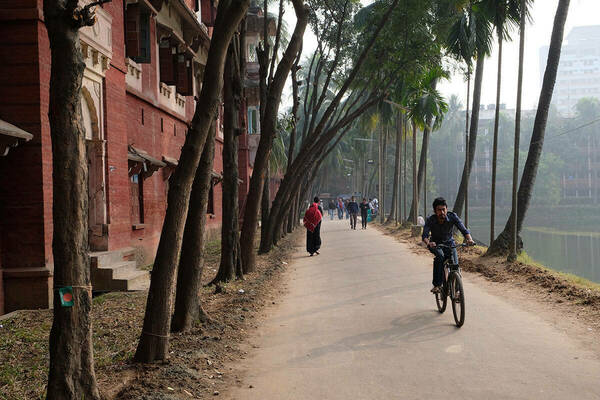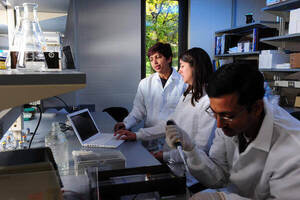
Between 2008 and 2020, districts across the country of Bangladesh saw a 93% reduction in malaria cases. Today, as the world reflects on the World Malaria Day 2024 theme, “accelerating the fight against malaria for a more equitable world,” researchers at the University of Notre Dame are developing new community-centered approaches to prevent a resurgence.
In addition to mosquito nets and nationally-driven diagnostic testing, antimalarial drugs have been a key to stopping the spread of malaria. However, in the remote regions of the Chittagong Hill Tracts (CHTs) in southeastern Bangladesh, under-resourced communities are facing a new challenge: antimalarial drug resistance.

Rev. Julius A. Nieuwland, C.S.C. Professor,
Department of Biological Sciences
Kasturi Haldar, Rev. Julius A. Nieuwland, C.S.C. Professor in the Department of Biological Sciences at the University of Notre Dame has spent the past seven years carefully studying malaria parasites in Bangladesh for signs of drug-resistant malaria. A faculty affiliate for the Eck Institute for Global Health, her work builds on the Congregation of Holy Cross’s long history of work in Bangladesh.
Through collaborations with assistant professor Cristian Koepfli, research professor Neil Lobo in the Department of Biological Sciences at Notre Dame, and researchers from the International Centre for Diarrheal Disease Research (ICDDR,b) in Dhaka, Bangladesh, Haldar published an assessment of the country’s malaria elimination efforts. The study builds upon Haldar’s clinical and laboratory investigations to prevent the transmission of artemisinin-resistant malaria parasites.
Artemisinin is an extract derived from a species of wormwood. Since its discovery by Nobel Prize winner, Tu Youyou, it has served as the frontline therapy for treating malaria when used in combination with other drugs. The wide use of artemisinin-based combination drugs contributed to a global reduction of malaria from 2010 to 2017. Since 2017, however, progress toward complete malaria elimination has slowed, in part due to emerging artemisinin resistance.
“Bangladesh has been very successful in eliminating malaria, but infection is still very high in the Chittagong Hill Tracts, where people travel from other areas of Bangladesh or from Myanmar as refugees,” says Haldar. The CHTs border the country of Myanmar, where a high prevalence of artemisinin-resistant malaria parasites have been found. “The major concern is that mosquitoes could transmit the artemisinin-resistant parasites from less developed areas on the border, into more populated areas of Bangladesh,” she explains.

To detect artemisinin-resistant parasites, Haldar developed clinical and laboratory assays at facilities in the remote regions of the CHTs. Her work has been supported by awards from the National Institutes of Health and Notre Dame’s Keough School of Global Affairs.
“In the populated areas of Bangladesh, the government has established an impressive system of community health workers who visit homes and conduct rapid diagnostic testing for malaria,” says Haldar, “but in the underserved areas of the CHTs, people travel many miles to the clinics for diagnosis and treatment. If they are infected with an artemisinin-resistant parasite, the treatment will not make them well.”
Slow parasite clearance among malaria-infected patients is the main indicator of artemisinin resistance. The clinical assays monitor the rate of parasite clearance in patients during six-hour intervals of administering artemisinin combination drugs. If the rate falls outside of the clearance algorithm, the parasite samples are further evaluated during laboratory assays.
Only one strain of artemisinin-resistant malaria has been found in samples during the laboratory assay, but Haldar recognizes a gap in the detection process. She explains, "If you really want to see what's going on out there, you have to be in the community. You need to see the person directly in their community.”
Strengthening the community-based private sector within Bangladesh is central to Haldar’s current malaria research.

(Photo cred: Matt Cashore/University of Notre Dame)
She is working with others to design a model to mobilize Bangladesh’s private sector of physicians, pharmacists, health workers, and traditional healers to detect and treat malaria on a larger scale. In the remote regions of the CHTs where resistance is easier to miss, Haldar’s model proposes the development of public-private connections between organizations that target the needs of the local communities and offer diagnostic test training to private sector providers.
“You have to take a comprehensive approach to ending malaria because it’s very complex,” Haldar adds. “You have to be vigilant. That’s our approach to eliminating malaria for good.”
“The University of Notre Dame is a leading force in malaria research,” says Dr. Bernard Nahlen, director of the Eck Institute for Global Health and professor of biological sciences. “Kasturi’s work reinforces the University’s strengths in vector-borne disease research, and underscores the Eck Institute’s commitment to international partnerships that can comprehensively address the complex health challenges in under-resourced communities that are most negatively impacted by malaria.”
To learn more about malaria research at the Eck Institute for Global Health, please visit the website.
Contact:
Christine Grashorn, Communications Specialist
Notre Dame Research / University of Notre Dame
cgrashor@nd.edu / 574.631.4856
research.nd.edu / @UNDResearch
About the Eck Institute for Global Health
The Eck Institute for Global Health (EIGH), an integral part of Notre Dame Research, builds on the University’s historical strength in infectious disease research, including vector-borne diseases, while broadening the interdisciplinary expertise into other key global health areas including maternal, newborn, and child health (MNCH); community health; mental health; nutrition and non-communicable diseases; the environment and health; health analytics and technologies; and health systems and organizations. Our team of interdisciplinary researchers and their students holistically address health disparities around the world. EIGH faculty affiliates recognize health as a fundamental human right and promote research, training, and service to advance health standards for all people, especially those in resource-poor countries who are disproportionately impacted by preventable diseases. The EIGH is training the next generation of global health researchers and leaders through undergraduate, Master of Science in Global Health, doctoral, and postdoctoral programs.
Originally published by at globalhealth.nd.edu on April 25, 2024.